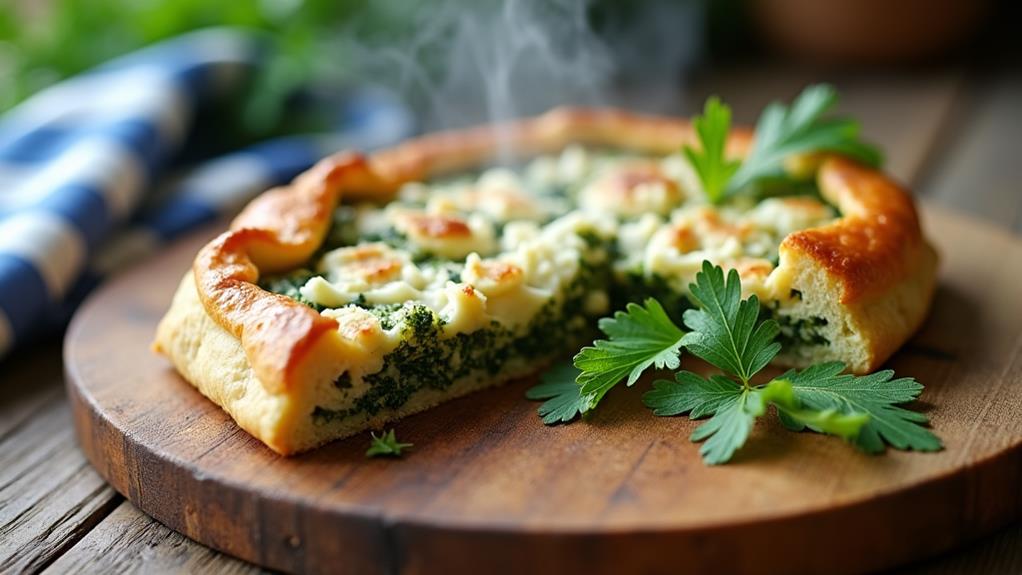You've likely heard of spanakopita, the beloved Greek spinach pie, but have you encountered its wild cousin, nettle spanakopita? This rustic variation swaps out cultivated spinach for foraged nettles, adding a bold, earthy twist to the classic dish. While nettles might seem intimidating due to their stinging leaves, they transform into a nutritious, flavorful ingredient when properly handled and cooked. As you explore this unique recipe, you'll discover not only a tasty meal but also a glimpse into the resourceful culinary traditions of rural Greece. There's more to uncover about this intriguing dish's history and preparation…
Key Takeaways
- Nettle Spanakopita is a Greek dish that substitutes traditional spinach with foraged nettle leaves in a flaky phyllo pastry.
- The recipe combines blanched nettles, feta cheese, and eggs as the main filling ingredients.
- Preparation involves layering phyllo sheets with the nettle mixture, brushing with olive oil for crispiness.
- Bake at 375°F (190°C) for 35-40 minutes until golden brown and crispy.
- Nettles offer nutritional benefits, including vitamins A, C, K, and minerals like iron and calcium.
History
Spanning centuries, the history of Nettle Spanakopita intertwines with both Greek culinary traditions and the age-old practice of foraging wild greens. You'll find that this dish's roots trace back to ancient Greece, where people often gathered wild plants for sustenance. Nettles, known for their nutritional value and abundance, became a staple in many rural diets.
As Greek cuisine evolved, the concept of wrapping ingredients in thin pastry layers emerged, giving birth to various filled pies. The traditional spinach pie, or spanakopita, gained popularity throughout the Mediterranean region. It's believed that creative cooks began substituting nettles for spinach in areas where these wild greens were plentiful.
The use of nettles in spanakopita represents a fusion of necessity and innovation. During lean times or in remote areas, nettles provided a free, nutritious alternative to cultivated greens. This adaptation showcases the resourcefulness of Greek cuisine, which often incorporates local, seasonal ingredients.
Today, Nettle Spanakopita serves as a delicious reminder of this culinary heritage, bridging ancient foraging practices with modern gastronomy. It's a testament to the enduring appeal of traditional recipes and the versatility of wild ingredients.
Recipe
Nettle Spanakopita is a delicious twist on the classic Greek spinach pie, replacing spinach with nutritious and flavorful nettles. This rustic dish combines the earthy taste of nettles with the rich, tangy flavor of feta cheese, all encased in crispy layers of phyllo pastry. It's an excellent way to use spring nettles and create a unique, savory treat that will impress your guests.
This simplified version of Nettle Spanakopita uses only five ingredients, making it an accessible recipe for those looking to experiment with wild greens or simply enjoy a comforting, Mediterranean-inspired dish. The nettles' stinging properties are neutralized during cooking, leaving behind a delicious green with a flavor reminiscent of spinach but with a more complex, nutty undertone.
- 4 cups (280g) fresh nettle leaves, cleaned and chopped
- 2 cups (300g) crumbled feta cheese
- 1 package (16 oz / 450g) phyllo pastry sheets
- 1/2 cup (120ml) olive oil
- 3 eggs, beaten
Preheat the oven to 375°F (190°C). Blanch the nettle leaves in boiling water for 2-3 minutes, then drain and squeeze out excess moisture. In a large bowl, mix the blanched nettles with crumbled feta and beaten eggs.
Layer half of the phyllo sheets in a greased 9×13 inch (23×33 cm) baking dish, brushing each sheet with olive oil. Spread the nettle mixture evenly over the phyllo, then cover with the remaining phyllo sheets, brushing each with oil. Score the top layers into squares and bake for 35-40 minutes until golden brown and crispy.
When handling fresh nettles, always wear gloves to avoid stings. If nettles are unavailable, spinach can be used as a substitute. For a crispier bottom crust, you can pre-bake the bottom phyllo layers for 5-10 minutes before adding the filling.
Leftover spanakopita can be stored in the refrigerator for up to 3 days and reheated in the oven to restore crispness.
Cooking Steps
To create your Nettle Spanakopita, you'll follow a series of simple cooking steps.
You'll start by gathering and cleaning the nettles, then blanching them in boiling water to neutralize their sting and soften the leaves.
Once the nettles are prepared, you'll mix them with the other filling ingredients, layer the phyllo dough and filling in your baking dish, and finally bake the spanakopita until it's golden brown and crispy.
Step 1. Gather and Clean Nettles
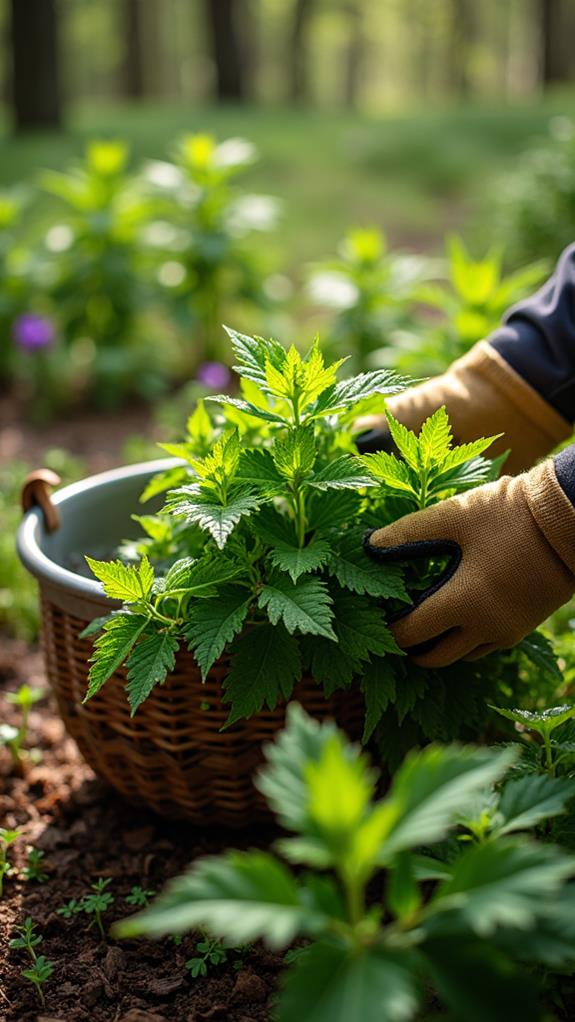
Before you can enjoy your delicious Nettle Spanakopita, you'll need to gather and clean the nettles properly. Start by locating a patch of young nettles in early spring, when they're most tender. Always wear thick gloves and long sleeves to protect yourself from their stinging hairs. Using scissors or pruning shears, cut the top 4-6 inches of the plants, avoiding any flowering or seeding nettles.
Once you've collected your nettles, it's time to clean them. Fill a large bowl with cold water and submerge the nettles, swishing them around to remove any dirt or debris. Drain the water and repeat this process two or three times until the water runs clear.
Next, remove any tough stems or discolored leaves. To neutralize the sting, blanch the nettles in boiling water for 2-3 minutes. After blanching, immediately plunge them into ice water to preserve their vibrant green color.
Step 2. Blanch Nettles in Boiling Water
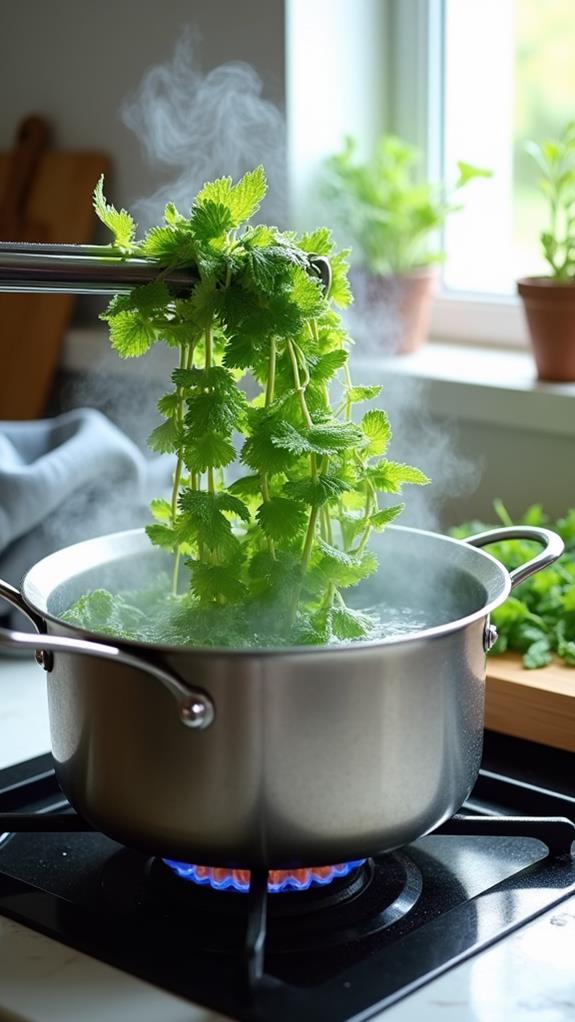
Once you've gathered and cleaned your nettles, it's time to blanch them. This crucial step not only neutralizes the stinging properties of the nettles but also softens their texture and preserves their vibrant green color.
Begin by bringing a large pot of water to a rolling boil. While you're waiting, prepare an ice bath in a separate bowl to shock the nettles after blanching.
Using tongs or gloved hands, carefully submerge the nettle leaves into the boiling water. Let them cook for 2-3 minutes, stirring occasionally to ensure even blanching. You'll notice the leaves wilting and becoming a deeper green color.
After the allotted time, quickly remove the nettles from the boiling water using a slotted spoon or spider strainer, and immediately plunge them into the ice bath. This stops the cooking process and helps retain their bright color.
Once cooled, drain the nettles thoroughly and squeeze out any excess moisture. You'll be left with a compact mass of blanched nettles, ready to be chopped and incorporated into your spanakopita filling.
Step 3. Mix Filling Ingredients Together
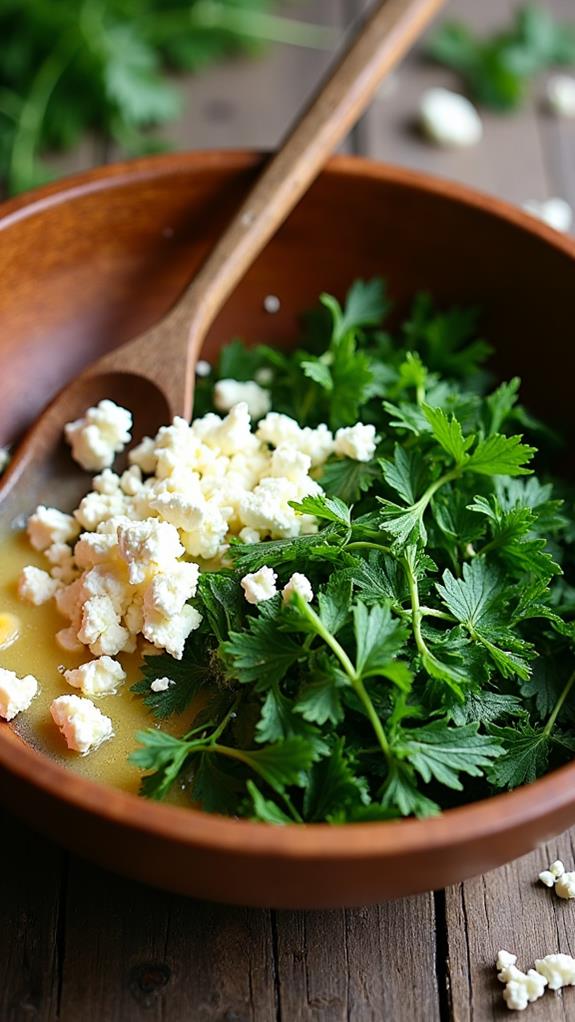
With your blanched nettles ready, it's time to create the flavorful filling for your spanakopita. In a large mixing bowl, combine the cooled, drained nettles with the crumbled feta cheese. The feta's salty, tangy flavor will complement the earthy taste of the nettles beautifully.
Next, add the beaten eggs to the mixture. These will act as a binder, helping to hold the filling together as it bakes. Using a spatula or your hands (make sure they're clean), thoroughly mix the ingredients until they're well combined.
You'll want to ensure that the feta is evenly distributed throughout the nettles and that the eggs are fully incorporated. As you mix, you may notice the filling becoming slightly more cohesive. This is exactly what you're looking for, as it'll help the spanakopita maintain its structure when sliced.
If the mixture seems too wet, you can add a small amount of breadcrumbs to absorb excess moisture. Once you're satisfied with the consistency, your filling is ready to be layered between the phyllo sheets.
Step 4. Layer Phyllo and Filling
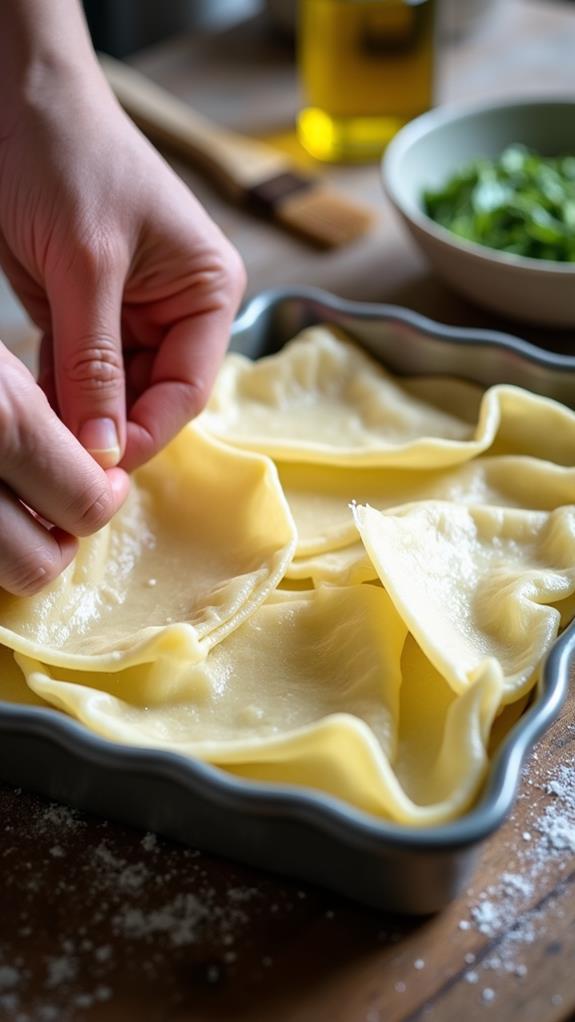
The layering process is crucial for achieving the perfect texture in your Nettle Spanakopita.
Begin by greasing your 9×13 inch baking dish with olive oil. Take half of your phyllo sheets and layer them one by one in the dish, brushing each sheet generously with olive oil before adding the next. This will create a crispy base for your pie.
Once you've used half the phyllo, it's time to add your nettle and feta mixture. Spread it evenly over the phyllo layers, ensuring it reaches all corners of the dish.
Now, you'll cover the filling with the remaining phyllo sheets. Continue the same process, layering each sheet and brushing with oil. As you near the top, be extra careful to keep the sheets smooth and wrinkle-free.
For the final touch, brush the top layer with a bit more oil to ensure a golden-brown finish. Before baking, score the top layers into squares with a sharp knife. This will make serving easier and allow steam to escape during cooking, resulting in a perfectly crispy top.
Step 5. Bake Until Golden Brown
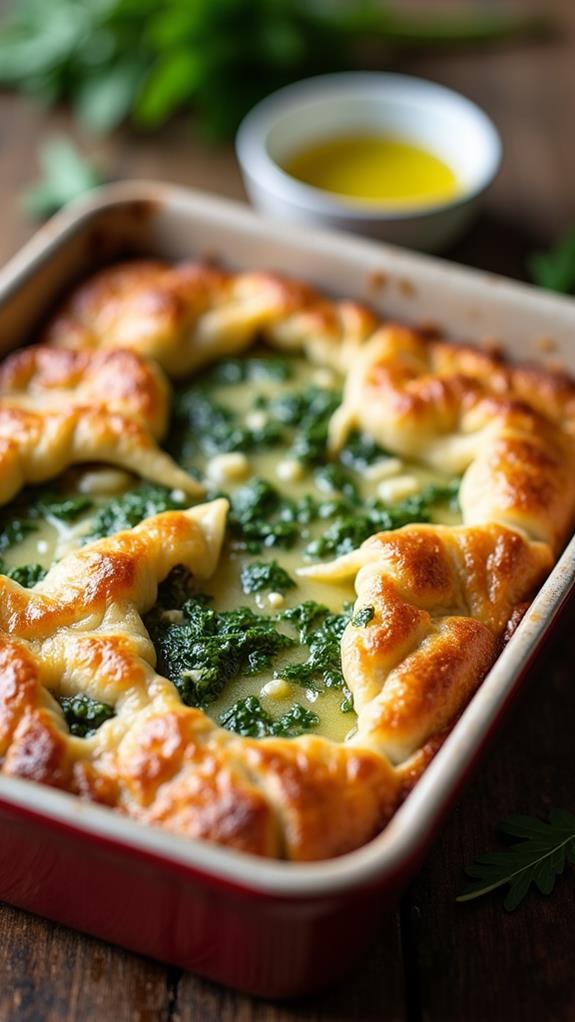
Now that you've prepared and layered your Nettle Spanakopita, it's time to bake it to perfection. Place your baking dish in the preheated oven at 375°F (190°C). You'll want to bake the spanakopita for 35-40 minutes, or until it achieves a beautiful golden-brown color on top.
During this time, the phyllo layers will crisp up, creating a delightful contrast to the soft, savory filling inside. Keep an eye on your spanakopita as it bakes. If you notice the top browning too quickly, you can cover it loosely with aluminum foil to prevent burning.
The spanakopita is done when the top is evenly golden and crispy, and you can hear a slight sizzle coming from the dish. To ensure it's cooked through, insert a knife into the center; it should come out clean and feel hot to the touch.
Once baked, remove the spanakopita from the oven and let it cool for 10-15 minutes before serving. This cooling period allows the filling to set, making it easier to cut and serve neat portions.
Final Thoughts
Despite its initial intimidation factor, Nettle Spanakopita is a rewarding dish that's well worth the effort.
You'll find that working with nettles isn't as daunting as it seems, especially once you've experienced the unique flavor they bring to this classic Greek pie.
As you bite into the crispy layers of phyllo and savor the creamy, tangy filling, you'll appreciate the subtle earthiness that sets this version apart from traditional spinach spanakopita.

